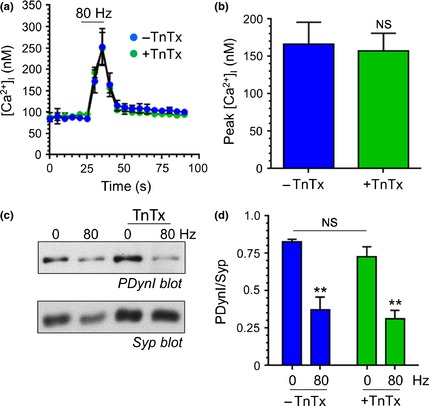Figure 3.

Tetanus toxin (TnTx) does not affect calcium influx or dynamin I dephosphorylation. Cultures were preincubated either with or without 2 nM TnTx for 24 h. (a and b) Cultures were loaded with fura‐2‐AM (10 μM) and then stimulated with a train of 800 action potentials (80 Hz). (a) Representative graphs display the fura‐2 response from TnTx‐treated (blue circles) and ‐untreated (green circles) cultures displayed as evoked increase in [Ca2+]i ± SEM. Bar indicates period of stimulation. (b) Quantification of the peak evoked [Ca2+]i response ± SEM for untreated (blue) or treated (green) cultures. Student's t‐test, p = 0.82, n = 3 independent experiments per condition. (c) Cultures treated with or without TnTx were either stimulated with a train of 800 action potentials (80 Hz) or left to rest for 10 s. Cultures were then immediately lysed in SDS sample buffer. Representative immunoblots of cerebellar granule neuron lysates probed with dynamin I phospho‐Ser774 antibodies (PDynI). The same blot was then reprobed with synaptophysin (Syp) antibodies. (d) Quantification of PDynI levels after normalisation against Syp (PDynI/Syp) ± SEM in untreated (blue) or untreated (green) cultures. **p < 0.01 for the evoked dephosphorylation in either TnTx‐treated or non‐treated lysates, one‐way AVOVA, n = 3 independent experiments per condition.
